Markets and Competition Essay: Developed vs. Underdeveloped Economies
VerifiedAdded on 2022/11/13
|10
|2801
|181
Essay
AI Summary
This essay examines the contrasting economic landscapes of developed and underdeveloped countries, focusing on markets and competition. It defines and differentiates between developed and underdeveloped nations, highlighting key indicators like GDP, income per capita, and living standards. The essay explores the impact of financial flows like foreign direct investment and remittances on economic growth. It further analyzes unemployment dynamics and the role of corruption in underdeveloped countries. The author argues in favor of establishing companies in underdeveloped areas, citing benefits such as job creation, increased GDP, and tax advantages, while acknowledging the importance of profitability and market share. The essay concludes by emphasizing the potential for companies to achieve global market success through strategic expansion into underdeveloped regions.
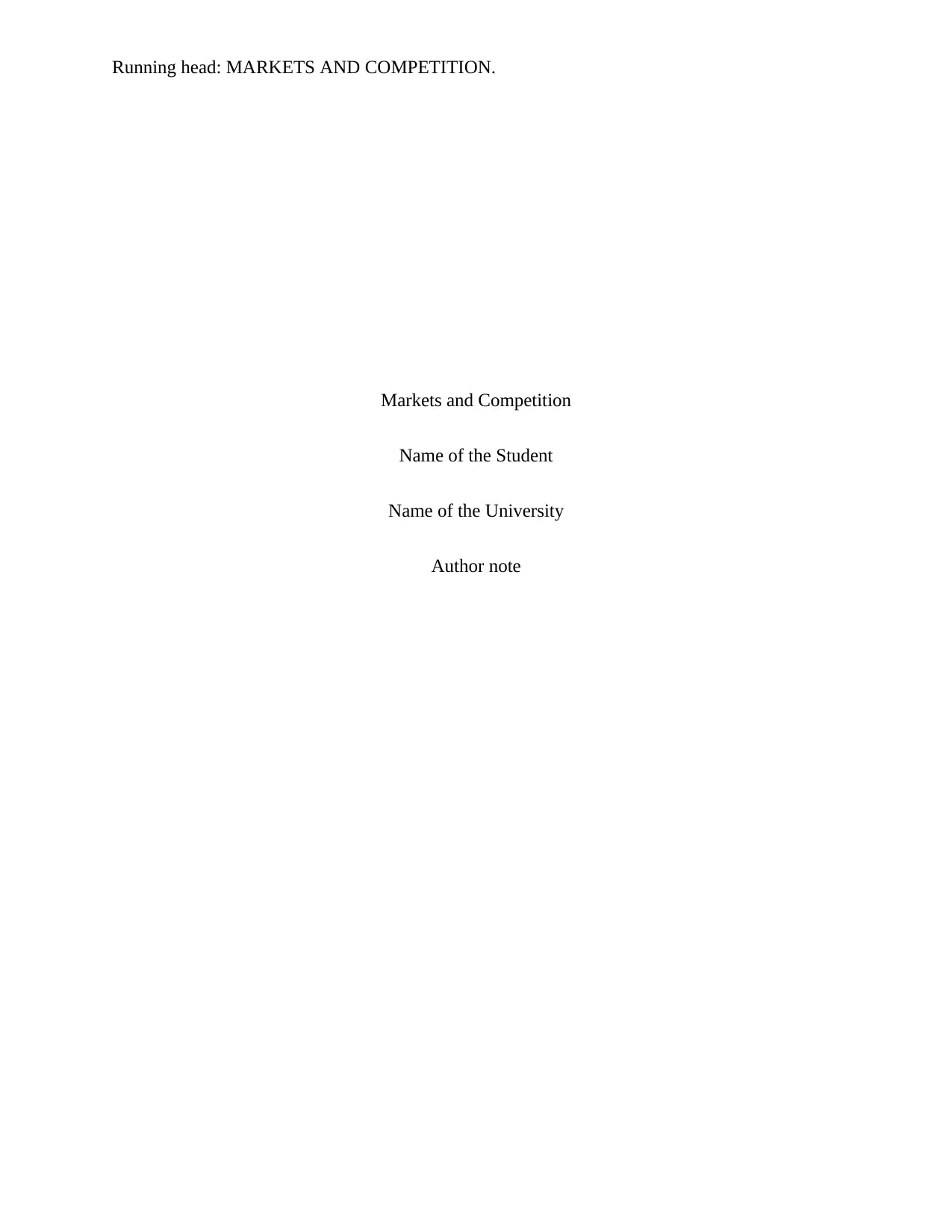
Running head: MARKETS AND COMPETITION.
Markets and Competition
Name of the Student
Name of the University
Author note
Markets and Competition
Name of the Student
Name of the University
Author note
Paraphrase This Document
Need a fresh take? Get an instant paraphrase of this document with our AI Paraphraser
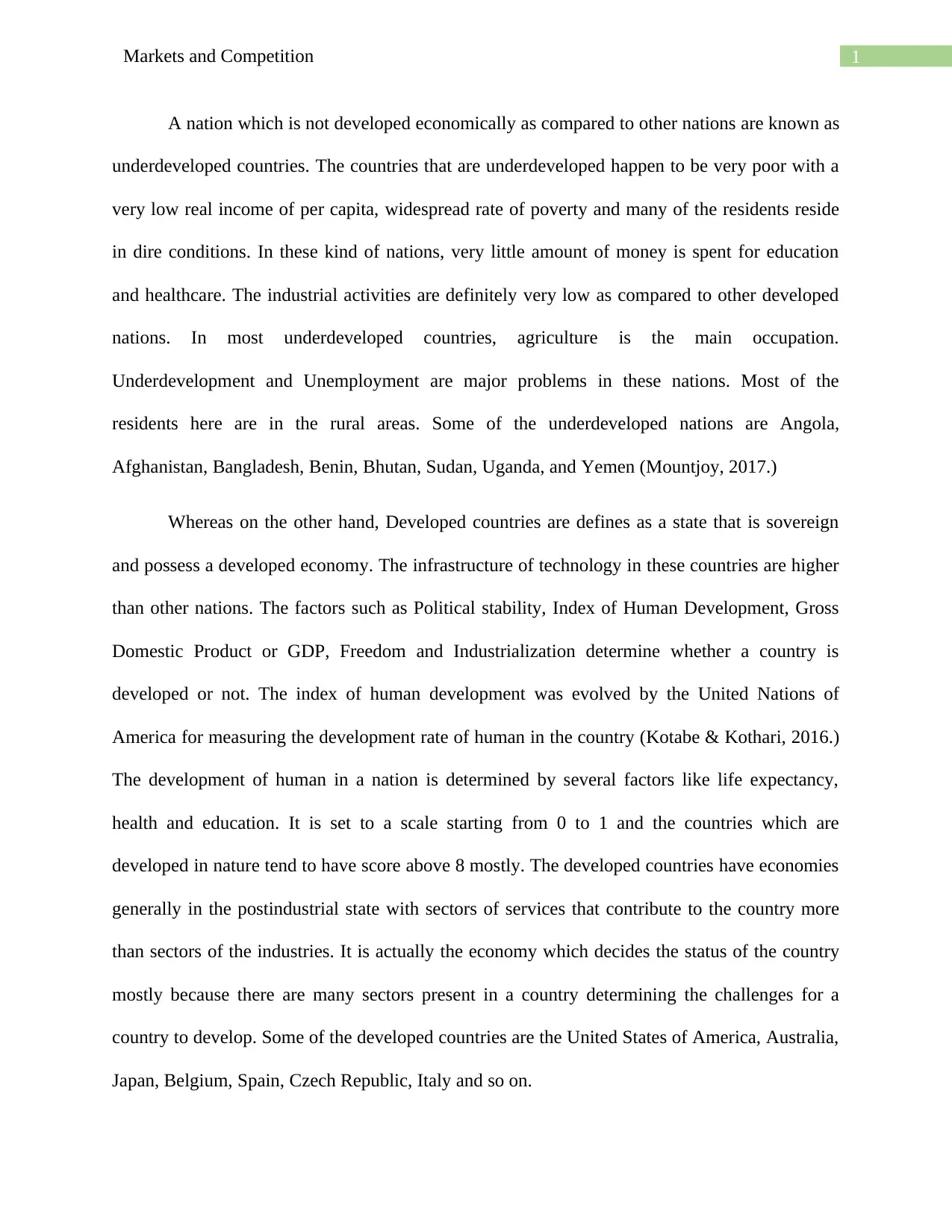
1Markets and Competition
A nation which is not developed economically as compared to other nations are known as
underdeveloped countries. The countries that are underdeveloped happen to be very poor with a
very low real income of per capita, widespread rate of poverty and many of the residents reside
in dire conditions. In these kind of nations, very little amount of money is spent for education
and healthcare. The industrial activities are definitely very low as compared to other developed
nations. In most underdeveloped countries, agriculture is the main occupation.
Underdevelopment and Unemployment are major problems in these nations. Most of the
residents here are in the rural areas. Some of the underdeveloped nations are Angola,
Afghanistan, Bangladesh, Benin, Bhutan, Sudan, Uganda, and Yemen (Mountjoy, 2017.)
Whereas on the other hand, Developed countries are defines as a state that is sovereign
and possess a developed economy. The infrastructure of technology in these countries are higher
than other nations. The factors such as Political stability, Index of Human Development, Gross
Domestic Product or GDP, Freedom and Industrialization determine whether a country is
developed or not. The index of human development was evolved by the United Nations of
America for measuring the development rate of human in the country (Kotabe & Kothari, 2016.)
The development of human in a nation is determined by several factors like life expectancy,
health and education. It is set to a scale starting from 0 to 1 and the countries which are
developed in nature tend to have score above 8 mostly. The developed countries have economies
generally in the postindustrial state with sectors of services that contribute to the country more
than sectors of the industries. It is actually the economy which decides the status of the country
mostly because there are many sectors present in a country determining the challenges for a
country to develop. Some of the developed countries are the United States of America, Australia,
Japan, Belgium, Spain, Czech Republic, Italy and so on.
A nation which is not developed economically as compared to other nations are known as
underdeveloped countries. The countries that are underdeveloped happen to be very poor with a
very low real income of per capita, widespread rate of poverty and many of the residents reside
in dire conditions. In these kind of nations, very little amount of money is spent for education
and healthcare. The industrial activities are definitely very low as compared to other developed
nations. In most underdeveloped countries, agriculture is the main occupation.
Underdevelopment and Unemployment are major problems in these nations. Most of the
residents here are in the rural areas. Some of the underdeveloped nations are Angola,
Afghanistan, Bangladesh, Benin, Bhutan, Sudan, Uganda, and Yemen (Mountjoy, 2017.)
Whereas on the other hand, Developed countries are defines as a state that is sovereign
and possess a developed economy. The infrastructure of technology in these countries are higher
than other nations. The factors such as Political stability, Index of Human Development, Gross
Domestic Product or GDP, Freedom and Industrialization determine whether a country is
developed or not. The index of human development was evolved by the United Nations of
America for measuring the development rate of human in the country (Kotabe & Kothari, 2016.)
The development of human in a nation is determined by several factors like life expectancy,
health and education. It is set to a scale starting from 0 to 1 and the countries which are
developed in nature tend to have score above 8 mostly. The developed countries have economies
generally in the postindustrial state with sectors of services that contribute to the country more
than sectors of the industries. It is actually the economy which decides the status of the country
mostly because there are many sectors present in a country determining the challenges for a
country to develop. Some of the developed countries are the United States of America, Australia,
Japan, Belgium, Spain, Czech Republic, Italy and so on.
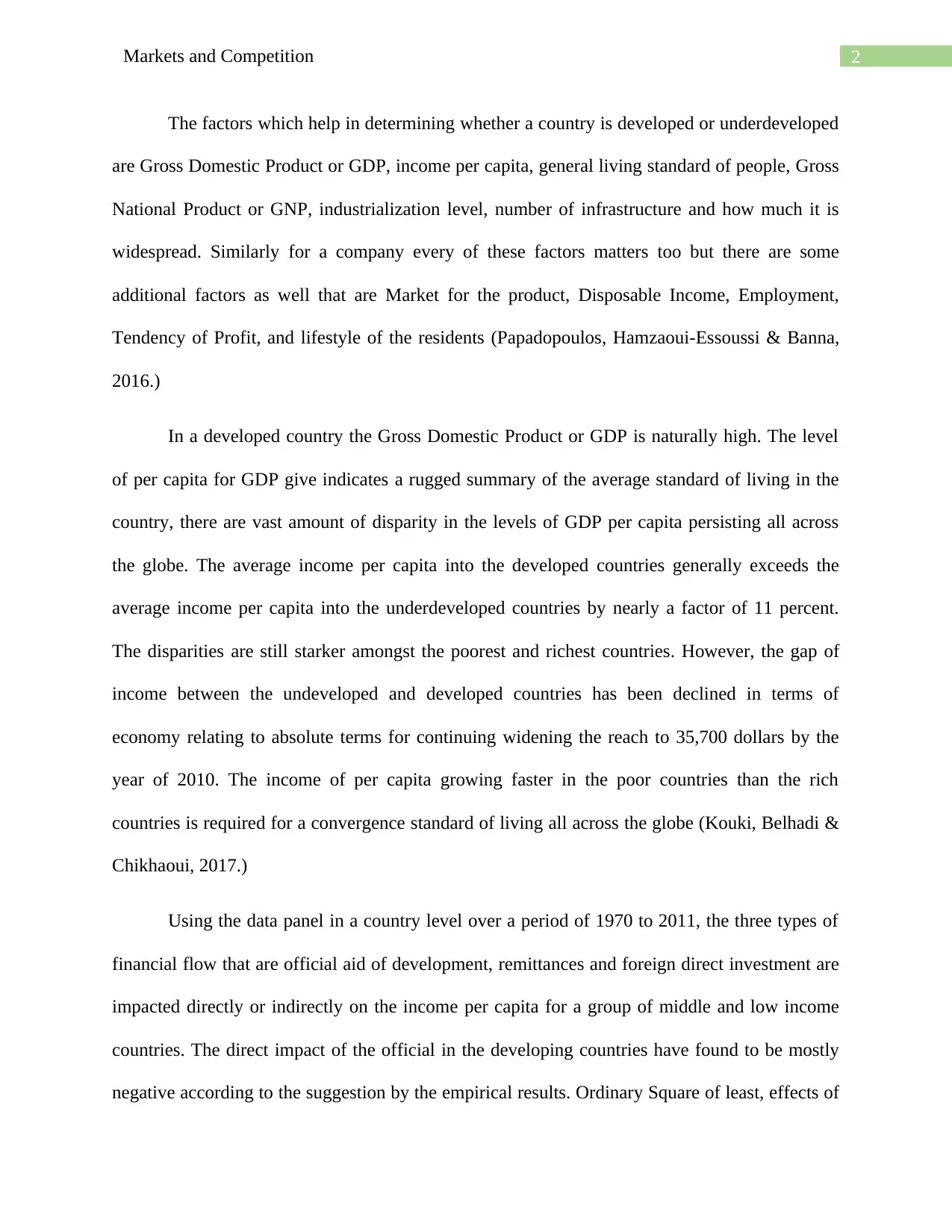
2Markets and Competition
The factors which help in determining whether a country is developed or underdeveloped
are Gross Domestic Product or GDP, income per capita, general living standard of people, Gross
National Product or GNP, industrialization level, number of infrastructure and how much it is
widespread. Similarly for a company every of these factors matters too but there are some
additional factors as well that are Market for the product, Disposable Income, Employment,
Tendency of Profit, and lifestyle of the residents (Papadopoulos, Hamzaoui-Essoussi & Banna,
2016.)
In a developed country the Gross Domestic Product or GDP is naturally high. The level
of per capita for GDP give indicates a rugged summary of the average standard of living in the
country, there are vast amount of disparity in the levels of GDP per capita persisting all across
the globe. The average income per capita into the developed countries generally exceeds the
average income per capita into the underdeveloped countries by nearly a factor of 11 percent.
The disparities are still starker amongst the poorest and richest countries. However, the gap of
income between the undeveloped and developed countries has been declined in terms of
economy relating to absolute terms for continuing widening the reach to 35,700 dollars by the
year of 2010. The income of per capita growing faster in the poor countries than the rich
countries is required for a convergence standard of living all across the globe (Kouki, Belhadi &
Chikhaoui, 2017.)
Using the data panel in a country level over a period of 1970 to 2011, the three types of
financial flow that are official aid of development, remittances and foreign direct investment are
impacted directly or indirectly on the income per capita for a group of middle and low income
countries. The direct impact of the official in the developing countries have found to be mostly
negative according to the suggestion by the empirical results. Ordinary Square of least, effects of
The factors which help in determining whether a country is developed or underdeveloped
are Gross Domestic Product or GDP, income per capita, general living standard of people, Gross
National Product or GNP, industrialization level, number of infrastructure and how much it is
widespread. Similarly for a company every of these factors matters too but there are some
additional factors as well that are Market for the product, Disposable Income, Employment,
Tendency of Profit, and lifestyle of the residents (Papadopoulos, Hamzaoui-Essoussi & Banna,
2016.)
In a developed country the Gross Domestic Product or GDP is naturally high. The level
of per capita for GDP give indicates a rugged summary of the average standard of living in the
country, there are vast amount of disparity in the levels of GDP per capita persisting all across
the globe. The average income per capita into the developed countries generally exceeds the
average income per capita into the underdeveloped countries by nearly a factor of 11 percent.
The disparities are still starker amongst the poorest and richest countries. However, the gap of
income between the undeveloped and developed countries has been declined in terms of
economy relating to absolute terms for continuing widening the reach to 35,700 dollars by the
year of 2010. The income of per capita growing faster in the poor countries than the rich
countries is required for a convergence standard of living all across the globe (Kouki, Belhadi &
Chikhaoui, 2017.)
Using the data panel in a country level over a period of 1970 to 2011, the three types of
financial flow that are official aid of development, remittances and foreign direct investment are
impacted directly or indirectly on the income per capita for a group of middle and low income
countries. The direct impact of the official in the developing countries have found to be mostly
negative according to the suggestion by the empirical results. Ordinary Square of least, effects of
⊘ This is a preview!⊘
Do you want full access?
Subscribe today to unlock all pages.

Trusted by 1+ million students worldwide
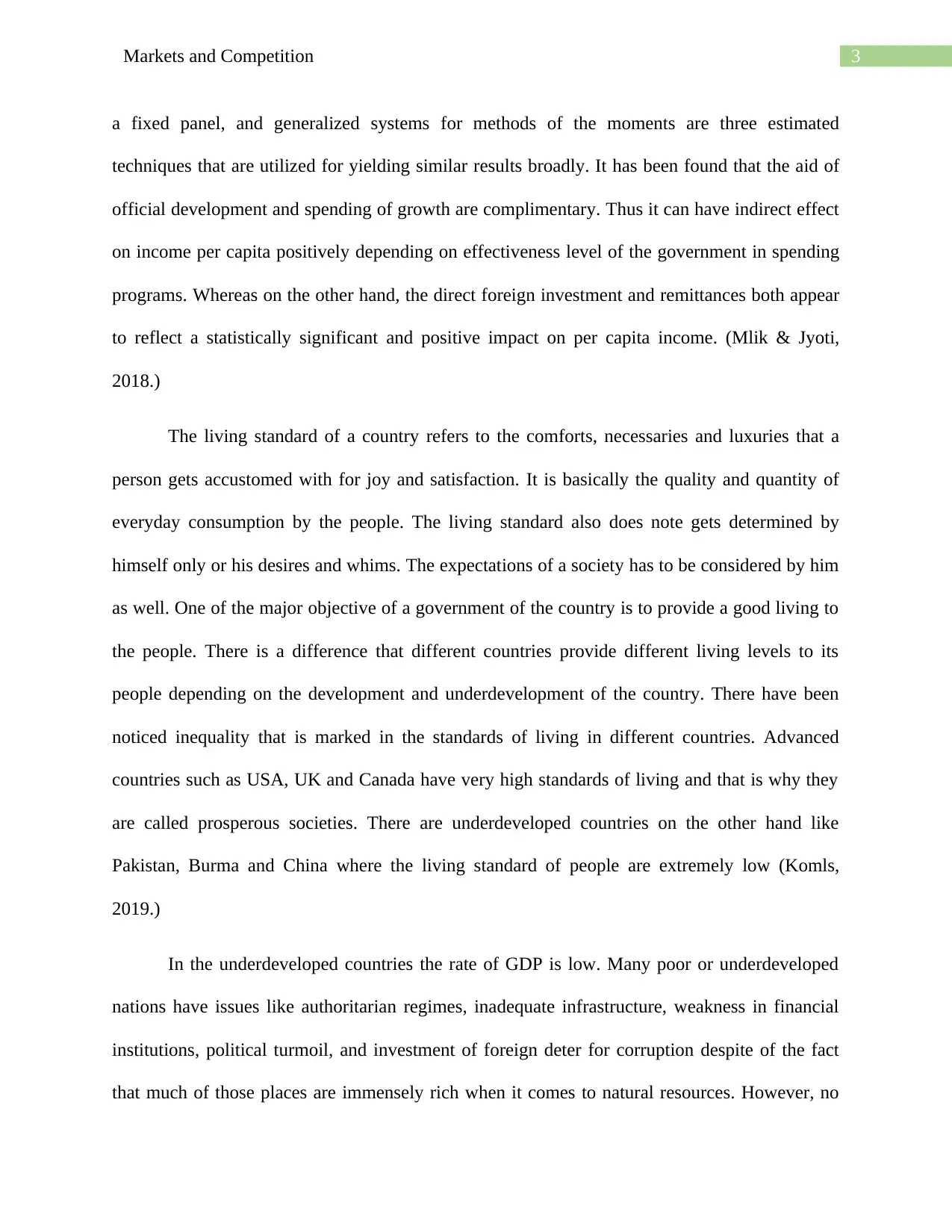
3Markets and Competition
a fixed panel, and generalized systems for methods of the moments are three estimated
techniques that are utilized for yielding similar results broadly. It has been found that the aid of
official development and spending of growth are complimentary. Thus it can have indirect effect
on income per capita positively depending on effectiveness level of the government in spending
programs. Whereas on the other hand, the direct foreign investment and remittances both appear
to reflect a statistically significant and positive impact on per capita income. (Mlik & Jyoti,
2018.)
The living standard of a country refers to the comforts, necessaries and luxuries that a
person gets accustomed with for joy and satisfaction. It is basically the quality and quantity of
everyday consumption by the people. The living standard also does note gets determined by
himself only or his desires and whims. The expectations of a society has to be considered by him
as well. One of the major objective of a government of the country is to provide a good living to
the people. There is a difference that different countries provide different living levels to its
people depending on the development and underdevelopment of the country. There have been
noticed inequality that is marked in the standards of living in different countries. Advanced
countries such as USA, UK and Canada have very high standards of living and that is why they
are called prosperous societies. There are underdeveloped countries on the other hand like
Pakistan, Burma and China where the living standard of people are extremely low (Komls,
2019.)
In the underdeveloped countries the rate of GDP is low. Many poor or underdeveloped
nations have issues like authoritarian regimes, inadequate infrastructure, weakness in financial
institutions, political turmoil, and investment of foreign deter for corruption despite of the fact
that much of those places are immensely rich when it comes to natural resources. However, no
a fixed panel, and generalized systems for methods of the moments are three estimated
techniques that are utilized for yielding similar results broadly. It has been found that the aid of
official development and spending of growth are complimentary. Thus it can have indirect effect
on income per capita positively depending on effectiveness level of the government in spending
programs. Whereas on the other hand, the direct foreign investment and remittances both appear
to reflect a statistically significant and positive impact on per capita income. (Mlik & Jyoti,
2018.)
The living standard of a country refers to the comforts, necessaries and luxuries that a
person gets accustomed with for joy and satisfaction. It is basically the quality and quantity of
everyday consumption by the people. The living standard also does note gets determined by
himself only or his desires and whims. The expectations of a society has to be considered by him
as well. One of the major objective of a government of the country is to provide a good living to
the people. There is a difference that different countries provide different living levels to its
people depending on the development and underdevelopment of the country. There have been
noticed inequality that is marked in the standards of living in different countries. Advanced
countries such as USA, UK and Canada have very high standards of living and that is why they
are called prosperous societies. There are underdeveloped countries on the other hand like
Pakistan, Burma and China where the living standard of people are extremely low (Komls,
2019.)
In the underdeveloped countries the rate of GDP is low. Many poor or underdeveloped
nations have issues like authoritarian regimes, inadequate infrastructure, weakness in financial
institutions, political turmoil, and investment of foreign deter for corruption despite of the fact
that much of those places are immensely rich when it comes to natural resources. However, no
Paraphrase This Document
Need a fresh take? Get an instant paraphrase of this document with our AI Paraphraser
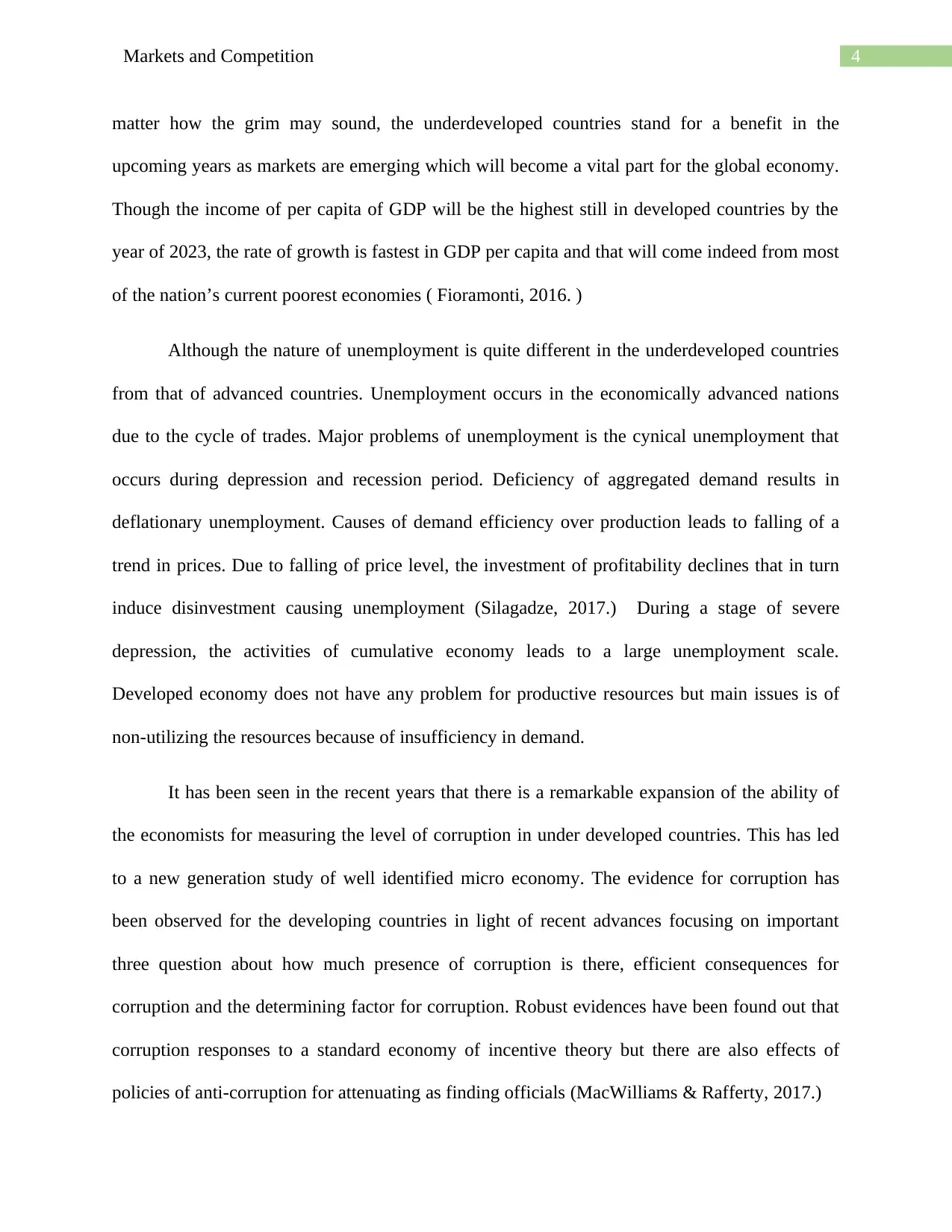
4Markets and Competition
matter how the grim may sound, the underdeveloped countries stand for a benefit in the
upcoming years as markets are emerging which will become a vital part for the global economy.
Though the income of per capita of GDP will be the highest still in developed countries by the
year of 2023, the rate of growth is fastest in GDP per capita and that will come indeed from most
of the nation’s current poorest economies ( Fioramonti, 2016. )
Although the nature of unemployment is quite different in the underdeveloped countries
from that of advanced countries. Unemployment occurs in the economically advanced nations
due to the cycle of trades. Major problems of unemployment is the cynical unemployment that
occurs during depression and recession period. Deficiency of aggregated demand results in
deflationary unemployment. Causes of demand efficiency over production leads to falling of a
trend in prices. Due to falling of price level, the investment of profitability declines that in turn
induce disinvestment causing unemployment (Silagadze, 2017.) During a stage of severe
depression, the activities of cumulative economy leads to a large unemployment scale.
Developed economy does not have any problem for productive resources but main issues is of
non-utilizing the resources because of insufficiency in demand.
It has been seen in the recent years that there is a remarkable expansion of the ability of
the economists for measuring the level of corruption in under developed countries. This has led
to a new generation study of well identified micro economy. The evidence for corruption has
been observed for the developing countries in light of recent advances focusing on important
three question about how much presence of corruption is there, efficient consequences for
corruption and the determining factor for corruption. Robust evidences have been found out that
corruption responses to a standard economy of incentive theory but there are also effects of
policies of anti-corruption for attenuating as finding officials (MacWilliams & Rafferty, 2017.)
matter how the grim may sound, the underdeveloped countries stand for a benefit in the
upcoming years as markets are emerging which will become a vital part for the global economy.
Though the income of per capita of GDP will be the highest still in developed countries by the
year of 2023, the rate of growth is fastest in GDP per capita and that will come indeed from most
of the nation’s current poorest economies ( Fioramonti, 2016. )
Although the nature of unemployment is quite different in the underdeveloped countries
from that of advanced countries. Unemployment occurs in the economically advanced nations
due to the cycle of trades. Major problems of unemployment is the cynical unemployment that
occurs during depression and recession period. Deficiency of aggregated demand results in
deflationary unemployment. Causes of demand efficiency over production leads to falling of a
trend in prices. Due to falling of price level, the investment of profitability declines that in turn
induce disinvestment causing unemployment (Silagadze, 2017.) During a stage of severe
depression, the activities of cumulative economy leads to a large unemployment scale.
Developed economy does not have any problem for productive resources but main issues is of
non-utilizing the resources because of insufficiency in demand.
It has been seen in the recent years that there is a remarkable expansion of the ability of
the economists for measuring the level of corruption in under developed countries. This has led
to a new generation study of well identified micro economy. The evidence for corruption has
been observed for the developing countries in light of recent advances focusing on important
three question about how much presence of corruption is there, efficient consequences for
corruption and the determining factor for corruption. Robust evidences have been found out that
corruption responses to a standard economy of incentive theory but there are also effects of
policies of anti-corruption for attenuating as finding officials (MacWilliams & Rafferty, 2017.)
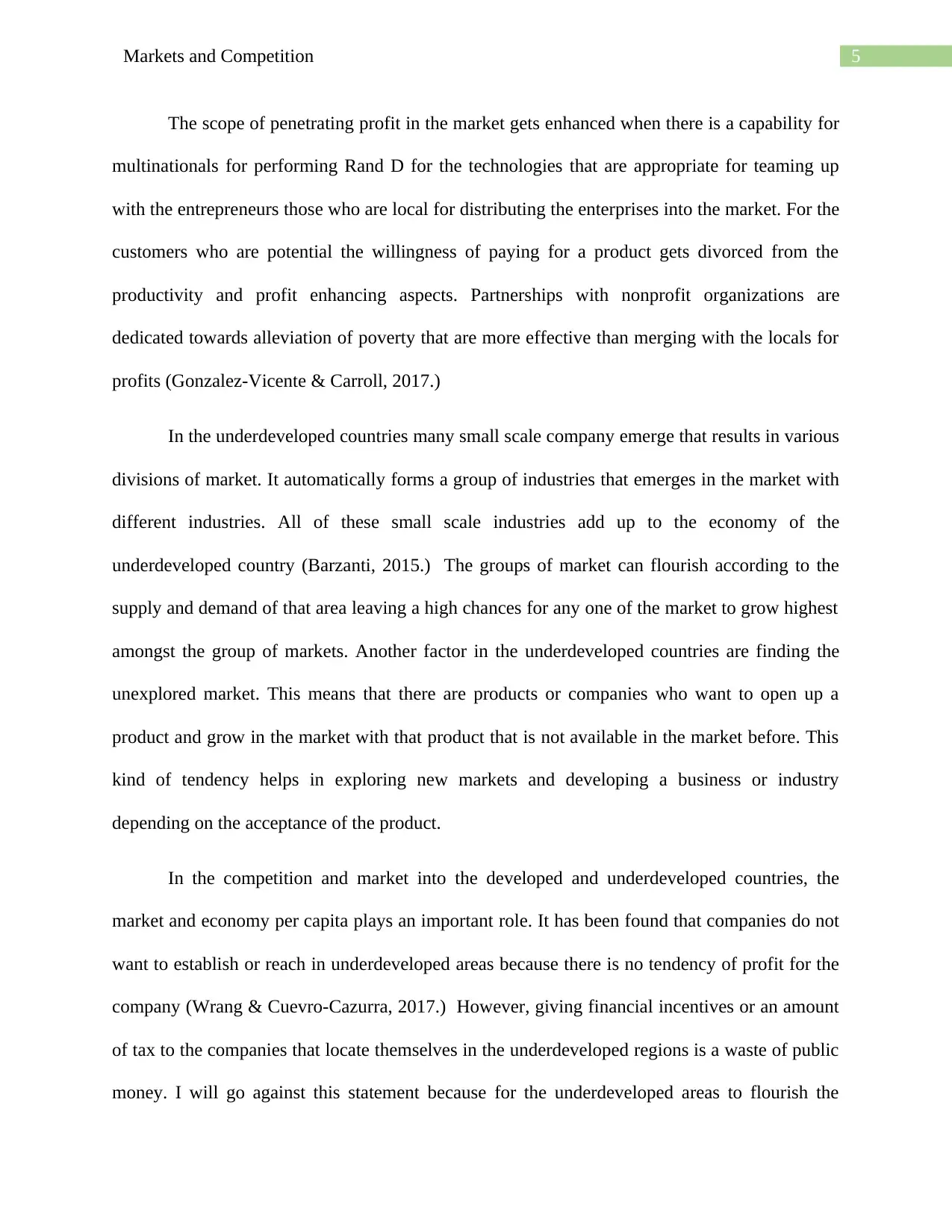
5Markets and Competition
The scope of penetrating profit in the market gets enhanced when there is a capability for
multinationals for performing Rand D for the technologies that are appropriate for teaming up
with the entrepreneurs those who are local for distributing the enterprises into the market. For the
customers who are potential the willingness of paying for a product gets divorced from the
productivity and profit enhancing aspects. Partnerships with nonprofit organizations are
dedicated towards alleviation of poverty that are more effective than merging with the locals for
profits (Gonzalez-Vicente & Carroll, 2017.)
In the underdeveloped countries many small scale company emerge that results in various
divisions of market. It automatically forms a group of industries that emerges in the market with
different industries. All of these small scale industries add up to the economy of the
underdeveloped country (Barzanti, 2015.) The groups of market can flourish according to the
supply and demand of that area leaving a high chances for any one of the market to grow highest
amongst the group of markets. Another factor in the underdeveloped countries are finding the
unexplored market. This means that there are products or companies who want to open up a
product and grow in the market with that product that is not available in the market before. This
kind of tendency helps in exploring new markets and developing a business or industry
depending on the acceptance of the product.
In the competition and market into the developed and underdeveloped countries, the
market and economy per capita plays an important role. It has been found that companies do not
want to establish or reach in underdeveloped areas because there is no tendency of profit for the
company (Wrang & Cuevro-Cazurra, 2017.) However, giving financial incentives or an amount
of tax to the companies that locate themselves in the underdeveloped regions is a waste of public
money. I will go against this statement because for the underdeveloped areas to flourish the
The scope of penetrating profit in the market gets enhanced when there is a capability for
multinationals for performing Rand D for the technologies that are appropriate for teaming up
with the entrepreneurs those who are local for distributing the enterprises into the market. For the
customers who are potential the willingness of paying for a product gets divorced from the
productivity and profit enhancing aspects. Partnerships with nonprofit organizations are
dedicated towards alleviation of poverty that are more effective than merging with the locals for
profits (Gonzalez-Vicente & Carroll, 2017.)
In the underdeveloped countries many small scale company emerge that results in various
divisions of market. It automatically forms a group of industries that emerges in the market with
different industries. All of these small scale industries add up to the economy of the
underdeveloped country (Barzanti, 2015.) The groups of market can flourish according to the
supply and demand of that area leaving a high chances for any one of the market to grow highest
amongst the group of markets. Another factor in the underdeveloped countries are finding the
unexplored market. This means that there are products or companies who want to open up a
product and grow in the market with that product that is not available in the market before. This
kind of tendency helps in exploring new markets and developing a business or industry
depending on the acceptance of the product.
In the competition and market into the developed and underdeveloped countries, the
market and economy per capita plays an important role. It has been found that companies do not
want to establish or reach in underdeveloped areas because there is no tendency of profit for the
company (Wrang & Cuevro-Cazurra, 2017.) However, giving financial incentives or an amount
of tax to the companies that locate themselves in the underdeveloped regions is a waste of public
money. I will go against this statement because for the underdeveloped areas to flourish the
⊘ This is a preview!⊘
Do you want full access?
Subscribe today to unlock all pages.

Trusted by 1+ million students worldwide
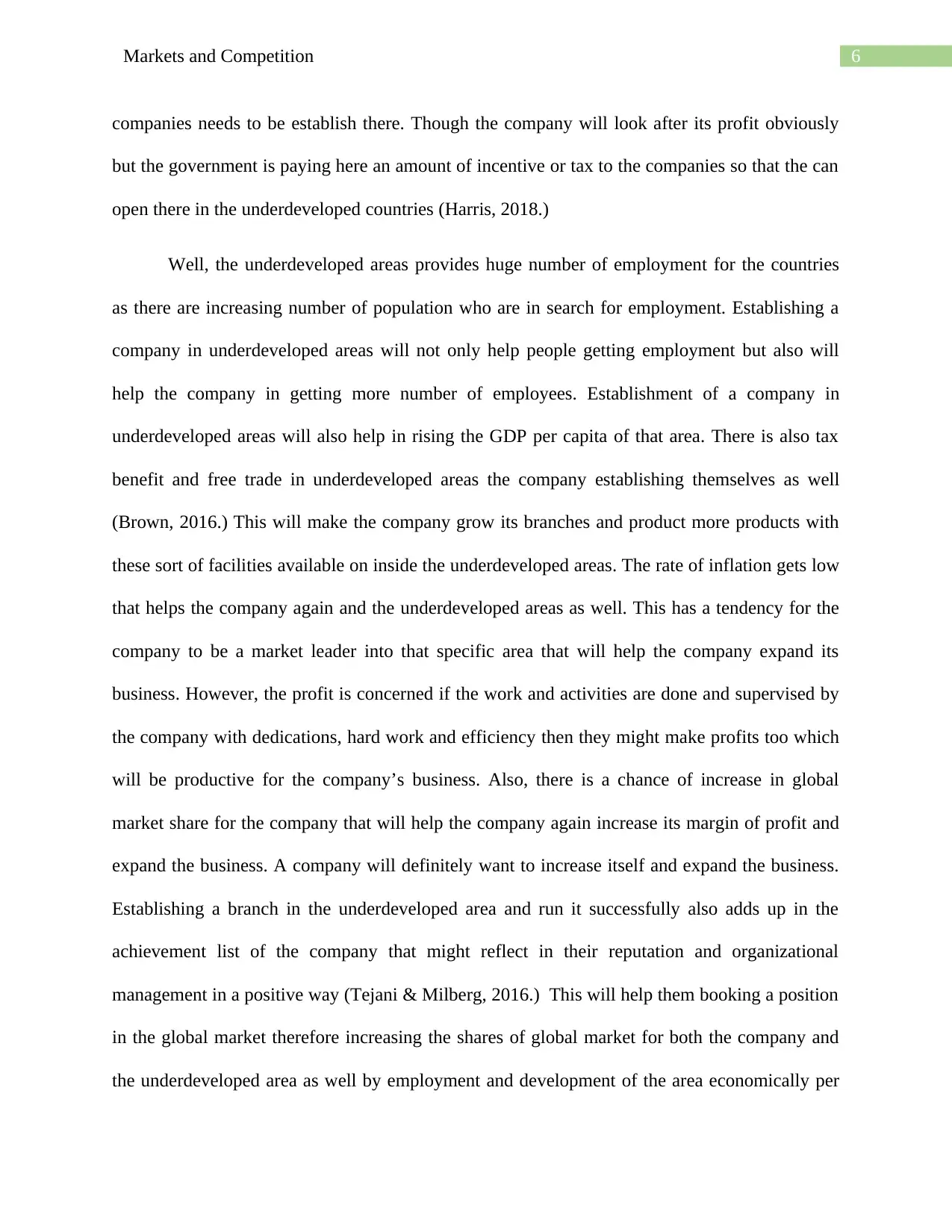
6Markets and Competition
companies needs to be establish there. Though the company will look after its profit obviously
but the government is paying here an amount of incentive or tax to the companies so that the can
open there in the underdeveloped countries (Harris, 2018.)
Well, the underdeveloped areas provides huge number of employment for the countries
as there are increasing number of population who are in search for employment. Establishing a
company in underdeveloped areas will not only help people getting employment but also will
help the company in getting more number of employees. Establishment of a company in
underdeveloped areas will also help in rising the GDP per capita of that area. There is also tax
benefit and free trade in underdeveloped areas the company establishing themselves as well
(Brown, 2016.) This will make the company grow its branches and product more products with
these sort of facilities available on inside the underdeveloped areas. The rate of inflation gets low
that helps the company again and the underdeveloped areas as well. This has a tendency for the
company to be a market leader into that specific area that will help the company expand its
business. However, the profit is concerned if the work and activities are done and supervised by
the company with dedications, hard work and efficiency then they might make profits too which
will be productive for the company’s business. Also, there is a chance of increase in global
market share for the company that will help the company again increase its margin of profit and
expand the business. A company will definitely want to increase itself and expand the business.
Establishing a branch in the underdeveloped area and run it successfully also adds up in the
achievement list of the company that might reflect in their reputation and organizational
management in a positive way (Tejani & Milberg, 2016.) This will help them booking a position
in the global market therefore increasing the shares of global market for both the company and
the underdeveloped area as well by employment and development of the area economically per
companies needs to be establish there. Though the company will look after its profit obviously
but the government is paying here an amount of incentive or tax to the companies so that the can
open there in the underdeveloped countries (Harris, 2018.)
Well, the underdeveloped areas provides huge number of employment for the countries
as there are increasing number of population who are in search for employment. Establishing a
company in underdeveloped areas will not only help people getting employment but also will
help the company in getting more number of employees. Establishment of a company in
underdeveloped areas will also help in rising the GDP per capita of that area. There is also tax
benefit and free trade in underdeveloped areas the company establishing themselves as well
(Brown, 2016.) This will make the company grow its branches and product more products with
these sort of facilities available on inside the underdeveloped areas. The rate of inflation gets low
that helps the company again and the underdeveloped areas as well. This has a tendency for the
company to be a market leader into that specific area that will help the company expand its
business. However, the profit is concerned if the work and activities are done and supervised by
the company with dedications, hard work and efficiency then they might make profits too which
will be productive for the company’s business. Also, there is a chance of increase in global
market share for the company that will help the company again increase its margin of profit and
expand the business. A company will definitely want to increase itself and expand the business.
Establishing a branch in the underdeveloped area and run it successfully also adds up in the
achievement list of the company that might reflect in their reputation and organizational
management in a positive way (Tejani & Milberg, 2016.) This will help them booking a position
in the global market therefore increasing the shares of global market for both the company and
the underdeveloped area as well by employment and development of the area economically per
Paraphrase This Document
Need a fresh take? Get an instant paraphrase of this document with our AI Paraphraser
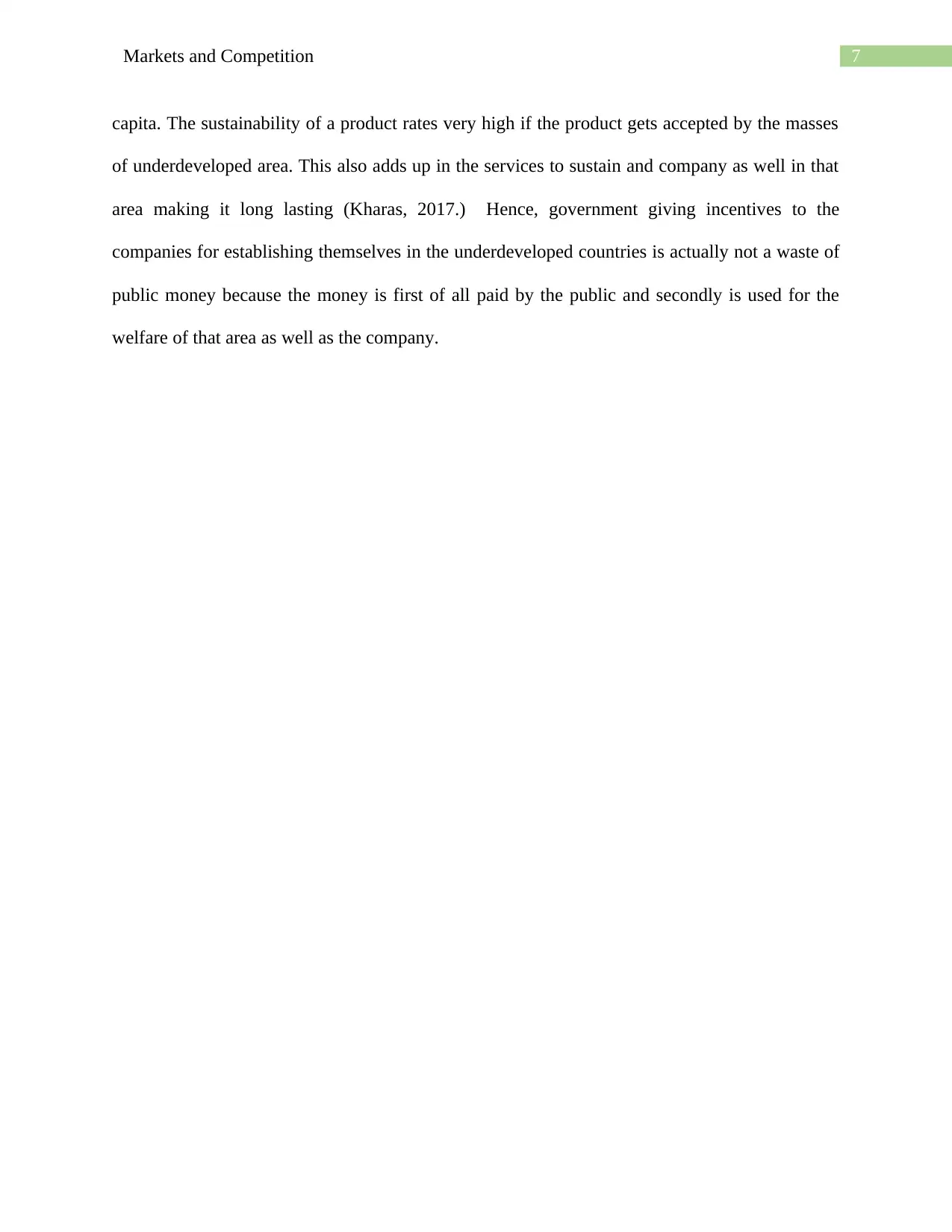
7Markets and Competition
capita. The sustainability of a product rates very high if the product gets accepted by the masses
of underdeveloped area. This also adds up in the services to sustain and company as well in that
area making it long lasting (Kharas, 2017.) Hence, government giving incentives to the
companies for establishing themselves in the underdeveloped countries is actually not a waste of
public money because the money is first of all paid by the public and secondly is used for the
welfare of that area as well as the company.
capita. The sustainability of a product rates very high if the product gets accepted by the masses
of underdeveloped area. This also adds up in the services to sustain and company as well in that
area making it long lasting (Kharas, 2017.) Hence, government giving incentives to the
companies for establishing themselves in the underdeveloped countries is actually not a waste of
public money because the money is first of all paid by the public and secondly is used for the
welfare of that area as well as the company.
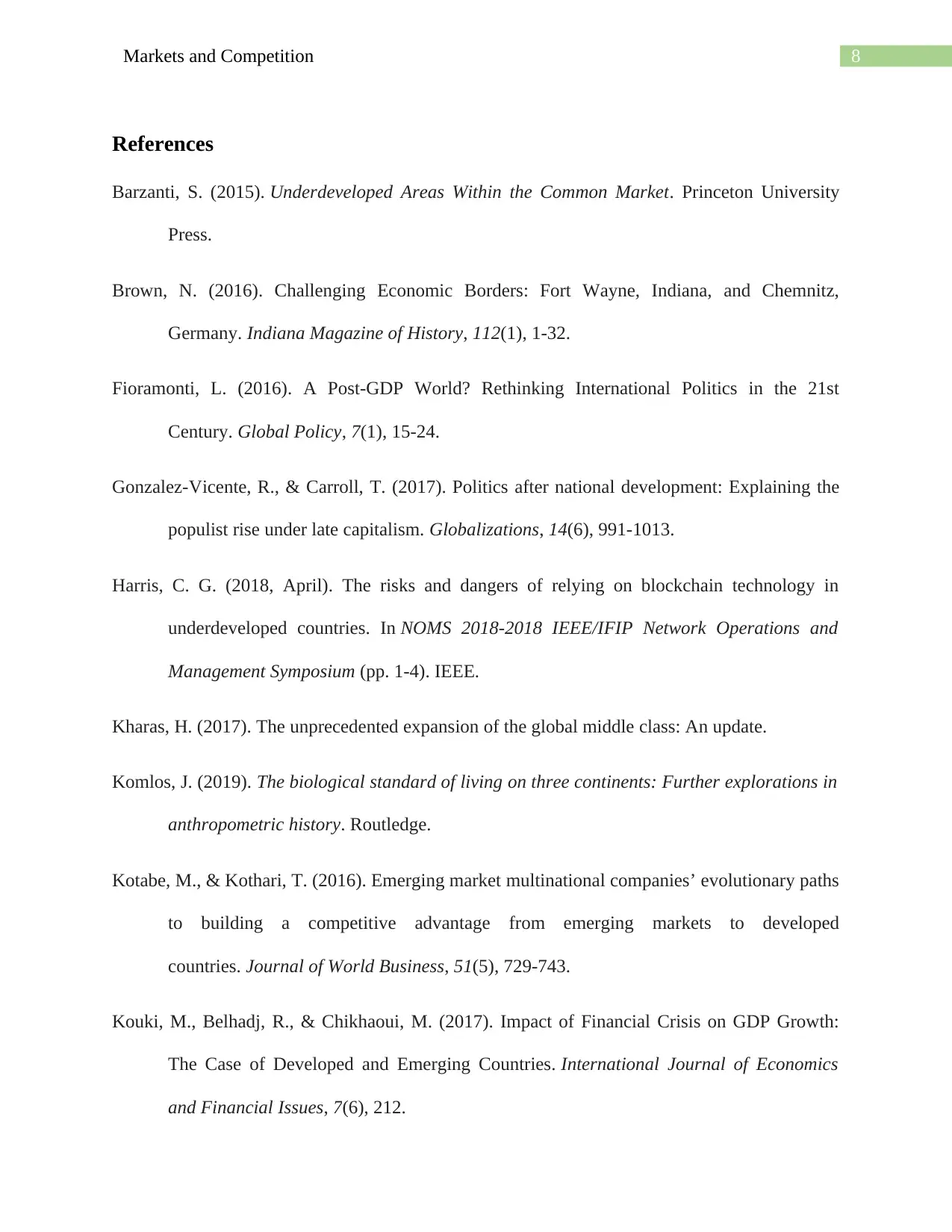
8Markets and Competition
References
Barzanti, S. (2015). Underdeveloped Areas Within the Common Market. Princeton University
Press.
Brown, N. (2016). Challenging Economic Borders: Fort Wayne, Indiana, and Chemnitz,
Germany. Indiana Magazine of History, 112(1), 1-32.
Fioramonti, L. (2016). A Post‐GDP World? Rethinking International Politics in the 21st
Century. Global Policy, 7(1), 15-24.
Gonzalez-Vicente, R., & Carroll, T. (2017). Politics after national development: Explaining the
populist rise under late capitalism. Globalizations, 14(6), 991-1013.
Harris, C. G. (2018, April). The risks and dangers of relying on blockchain technology in
underdeveloped countries. In NOMS 2018-2018 IEEE/IFIP Network Operations and
Management Symposium (pp. 1-4). IEEE.
Kharas, H. (2017). The unprecedented expansion of the global middle class: An update.
Komlos, J. (2019). The biological standard of living on three continents: Further explorations in
anthropometric history. Routledge.
Kotabe, M., & Kothari, T. (2016). Emerging market multinational companies’ evolutionary paths
to building a competitive advantage from emerging markets to developed
countries. Journal of World Business, 51(5), 729-743.
Kouki, M., Belhadj, R., & Chikhaoui, M. (2017). Impact of Financial Crisis on GDP Growth:
The Case of Developed and Emerging Countries. International Journal of Economics
and Financial Issues, 7(6), 212.
References
Barzanti, S. (2015). Underdeveloped Areas Within the Common Market. Princeton University
Press.
Brown, N. (2016). Challenging Economic Borders: Fort Wayne, Indiana, and Chemnitz,
Germany. Indiana Magazine of History, 112(1), 1-32.
Fioramonti, L. (2016). A Post‐GDP World? Rethinking International Politics in the 21st
Century. Global Policy, 7(1), 15-24.
Gonzalez-Vicente, R., & Carroll, T. (2017). Politics after national development: Explaining the
populist rise under late capitalism. Globalizations, 14(6), 991-1013.
Harris, C. G. (2018, April). The risks and dangers of relying on blockchain technology in
underdeveloped countries. In NOMS 2018-2018 IEEE/IFIP Network Operations and
Management Symposium (pp. 1-4). IEEE.
Kharas, H. (2017). The unprecedented expansion of the global middle class: An update.
Komlos, J. (2019). The biological standard of living on three continents: Further explorations in
anthropometric history. Routledge.
Kotabe, M., & Kothari, T. (2016). Emerging market multinational companies’ evolutionary paths
to building a competitive advantage from emerging markets to developed
countries. Journal of World Business, 51(5), 729-743.
Kouki, M., Belhadj, R., & Chikhaoui, M. (2017). Impact of Financial Crisis on GDP Growth:
The Case of Developed and Emerging Countries. International Journal of Economics
and Financial Issues, 7(6), 212.
⊘ This is a preview!⊘
Do you want full access?
Subscribe today to unlock all pages.

Trusted by 1+ million students worldwide
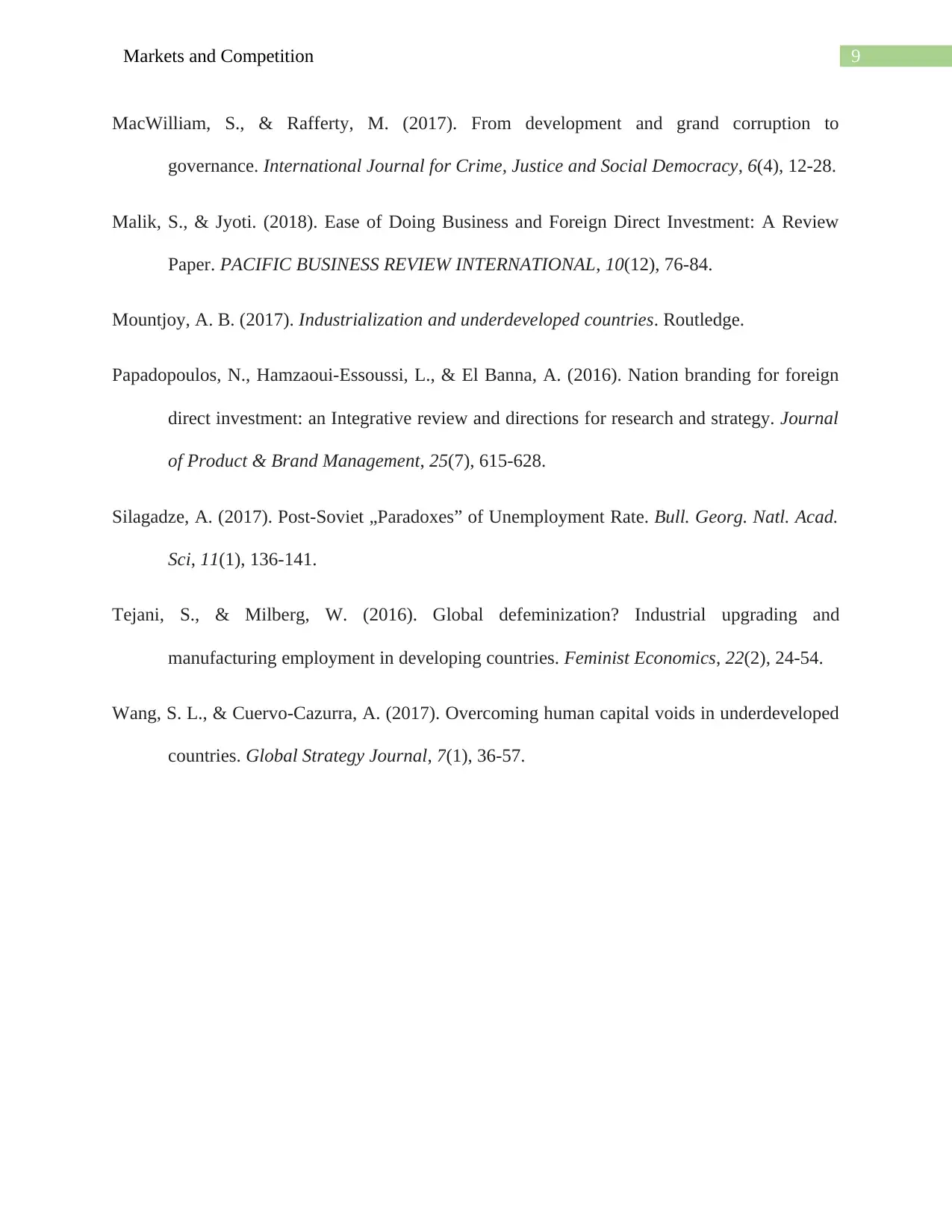
9Markets and Competition
MacWilliam, S., & Rafferty, M. (2017). From development and grand corruption to
governance. International Journal for Crime, Justice and Social Democracy, 6(4), 12-28.
Malik, S., & Jyoti. (2018). Ease of Doing Business and Foreign Direct Investment: A Review
Paper. PACIFIC BUSINESS REVIEW INTERNATIONAL, 10(12), 76-84.
Mountjoy, A. B. (2017). Industrialization and underdeveloped countries. Routledge.
Papadopoulos, N., Hamzaoui-Essoussi, L., & El Banna, A. (2016). Nation branding for foreign
direct investment: an Integrative review and directions for research and strategy. Journal
of Product & Brand Management, 25(7), 615-628.
Silagadze, A. (2017). Post-Soviet „Paradoxes” of Unemployment Rate. Bull. Georg. Natl. Acad.
Sci, 11(1), 136-141.
Tejani, S., & Milberg, W. (2016). Global defeminization? Industrial upgrading and
manufacturing employment in developing countries. Feminist Economics, 22(2), 24-54.
Wang, S. L., & Cuervo‐Cazurra, A. (2017). Overcoming human capital voids in underdeveloped
countries. Global Strategy Journal, 7(1), 36-57.
MacWilliam, S., & Rafferty, M. (2017). From development and grand corruption to
governance. International Journal for Crime, Justice and Social Democracy, 6(4), 12-28.
Malik, S., & Jyoti. (2018). Ease of Doing Business and Foreign Direct Investment: A Review
Paper. PACIFIC BUSINESS REVIEW INTERNATIONAL, 10(12), 76-84.
Mountjoy, A. B. (2017). Industrialization and underdeveloped countries. Routledge.
Papadopoulos, N., Hamzaoui-Essoussi, L., & El Banna, A. (2016). Nation branding for foreign
direct investment: an Integrative review and directions for research and strategy. Journal
of Product & Brand Management, 25(7), 615-628.
Silagadze, A. (2017). Post-Soviet „Paradoxes” of Unemployment Rate. Bull. Georg. Natl. Acad.
Sci, 11(1), 136-141.
Tejani, S., & Milberg, W. (2016). Global defeminization? Industrial upgrading and
manufacturing employment in developing countries. Feminist Economics, 22(2), 24-54.
Wang, S. L., & Cuervo‐Cazurra, A. (2017). Overcoming human capital voids in underdeveloped
countries. Global Strategy Journal, 7(1), 36-57.
1 out of 10
Related Documents
Your All-in-One AI-Powered Toolkit for Academic Success.
+13062052269
info@desklib.com
Available 24*7 on WhatsApp / Email
![[object Object]](/_next/static/media/star-bottom.7253800d.svg)
Unlock your academic potential
Copyright © 2020–2025 A2Z Services. All Rights Reserved. Developed and managed by ZUCOL.





